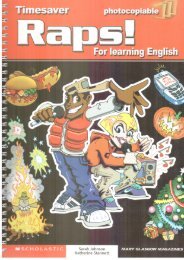English_Book_2-Teacher_300913
English_Book_2-Teacher_300913
English_Book_2-Teacher_300913
You also want an ePaper? Increase the reach of your titles
YUMPU automatically turns print PDFs into web optimized ePapers that Google loves.
Grammar Focusand Discovering grammar (15 min.)Imperatives☞ See Grammar reference, page 98.• Explain the uses of imperatives by modeling. Tellstudents Listen and do what I say. Open your book topage 48. (give instructions) Stand up. (give orders)Tell a student Please give me your pencil. (make apolite request) Point behind the class and say Lookout! (give a warning) For each ask What did I askyou to do? How did I say it? Write the phrases onthe board. State the function (for example, giveinstructions) of each phrase.• Have students look at the grammar chart as youread each example aloud.• Have students work individually to complete theexercise. Check answers orally.Answer key1. verb2. Don’t3. base form• Use the board to elicit other key points aboutthe grammar chart, such as the fact that mostimperatives begin with the base form of the verband that negative imperatives usually begin withDon’t. (See the Grammar reference.)Practicing grammar5 Practice (15 min.)A.• Have students read the directions and example.Elicit several examples of affirmative commands;for example, Read the dialogue, Raise your hand,Please listen. Write them on the board.• Have students work individually or in pairs tocomplete the exercise. Walk around, helpingstudents as needed.• Check by calling on several volunteers to tell theclass one of their imperatives.Answer key: A, B, CAnswers will vary.B.• Read the instructions aloud, and then ask studentsWhat’s the verb in number one?• Have students underline the verbs in thecommands they made for Exercise A.C.• Read the instructions aloud, and then ask studentsWhat’s the negative command in number one? How doyou make it negative? (begin with Don’t)• Have students work individually to write outnegative commands.• Ask several volunteers to share their negativecommands.D.• PAIRS. Read the instructions and call on a pair tomodel giving and following a few commands forthe class.• To conclude this exercise, call on a pair to givecommands to the whole class.6 Practice• GROUPS. Turn to page 68 and let students have acompetition.Have students complete Workbook Exercises 3–8and Grammar Builder Exercises 1–4.(10 min.)A.• GROUPS. Read the instructions aloud and writethe two questions on the board. Chorus the Usefullanguage with the class. Then model the beginningof a discussion with one or more students.• Assign groups and have students discuss.B.• GROUPS. Read the instructions. Write on theboard Dos and Don’ts. Tell students that they willwrite rules to make the school a better place. Tellthem that Dos are rules in the affirmative, whileDon’ts are in the negative.• Read the first example aloud. Ask Is this a Do ora Don’t? (a Do) Write this under Do on the board.Elicit another example of a Do rule from studentsto write on the board. Then elicit two Don’texamples to list under Don’t.• Assign groups of three or four students.As students are working, circulate to helpwith vocabulary.• Call on several groups to share their lists with theclass. Discuss the lists by asking the class WhatDos and Don’ts are on many lists? What are the mostimportant? What are the most interesting?TEACHER’S NOTEST8:25:47 PMPostcards_splitB_TE1_U01.indd T82/27/07 10:23:40 AM




